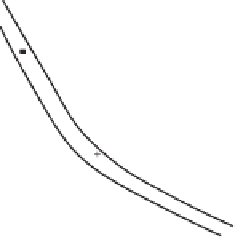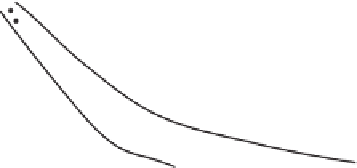Environmental Engineering Reference
In-Depth Information
1,000,000
1,000,000
Leong et al. (2002)
Fawcett & Collis-George (1967)
Hamblin (1981)
Chandler & Gutierrez (1986)
Sibley & Williams (1990)
Ridley (1995)
Harrison & Blight (1998)
Fawcett & Collis-George (1967)
Hamblin (1981)
Gutierrez (1985)
Duran (1986)
Chandler & Gutierrez (1986)
Chandler et al., (1992)
100,000
100,000
10,000
10,000
From solution
1,000
1,000
From suction plate, pressure plate,
and pressure membrane extractor
100
100
10
10
1
1
0
20
40
60
80
100
120
140
160
0
20
40
60
80
100
120
140
160
180
200
Filter paper water content, %
Filter paper water content, %
(a)
(a)
1,000,000
1,000,000
Leong et al. (2002)
Gardner (1937)
McQueen & Miller (1968)
Al-Khafaf & Hanks (1974)
Harrison & Blight (1998)
Gardner (1937)
McQueen & Miller (1968)
Al-Khafaf & Hanks (1974)
100,000
100,000
10,000
From solution
10,000
1,000
1,000
From suction plate, pressure plate,
and pressure membrane extractor
100
100
10
10
1
1
0
20
40
60
80
100
120
140
160
0
20
40
60
80
100
120
140
160
180
200
Filter paper water content, %
Filter paper water content, %
(b)
(b)
Figure 4.77
Calibration data obtained from different batches
of filter paper (from Rahardjo and Leong, 2006): (a) data from
Whatman No. 42 filter paper; (b) data from Schleicher and Schuell
No. 589 filter paper.
Figure 4.78
Calibration data obtained when equilibrating filter
paper with soils of known soil suction (from Rahardjo and Leong,
2006): (a) data from Whatman No. 42 filter paper; (b) data from
Schleicher and Schuell No. 589 filter paper.
Soil samples of “known” soil suction have also been used
for the calibration of filter paper. Soil samples conditioned
at known heights above the groundwater table have been
used for suctions less than 20 kPa (Gardner, 1937; McQueen
and Miller, 1968a; Al-Khafaf and Hanks, 1974). Saturated
soil samples have also been consolidated in an oedometer
or triaxial apparatus and then rapidly unloaded. The matric
suction generated in a soil sample is assumed to be equal to
the applied effective stress. Matric suctions up to 2000 kPa
can be generated in this manner provided the soil sample
remains saturated (Gutierrez 1985; Chandler and Gutierrez,
1986; Duran, 1986; Chandler et al., 1992).
Matric suctions can also be generated in soil samples using
a pressure membrane extractor, a pressure plate apparatus, or
a suction plate apparatus (McQueen and Miller, 1968a; Al-
Khafaf and Hanks, 1974; Hamblin, 1981; Chandler et al.,
1992). Calibration data obtained using soil samples with
applied matric suctions are plotted in Fig. 4.78a for What-
man No. 42 filter paper and Fig. 4.78b for Schleicher and
Schuell No. 589 filter paper. The data show considerable
scatter, suggesting that the use of soil samples with applied
matric suction may not be the most reliable procedure to use
for the calibration of filter paper.
Hysteresis.
The drying and wetting of porous materi-
als are known to show hysteretic behavior. It is possible
that filter paper may also show hysteresis during drying
and wetting. Experimental evidence of filter paper hysteresis
was suggested by Williams and Sedgley (1965) and Fawcett
and Collis-George (1967). Al-Khafaf and Hanks (1974) sug-
gested that filter paper should always be calibrated in the
same manner to avoid issues related to hysteresis. Sibley
and Williams (1990) and Swarbrick (1995) suggested that
soil suction measurements with filter paper should be con-
sistent with whether a wetting or drying procedure was used
during calibration.
Ridley (1995) showed matric suction calibration data on
Whatman No. 42 filter paper where hysteresis was notice-
able. Harrison and Blight (1998) showed calibration data for
Whatman No. 42 and Schleicher and Schuell No. 589 filter
papers under drying and wetting conditions and hysteresis








































































































Search WWH ::

Custom Search